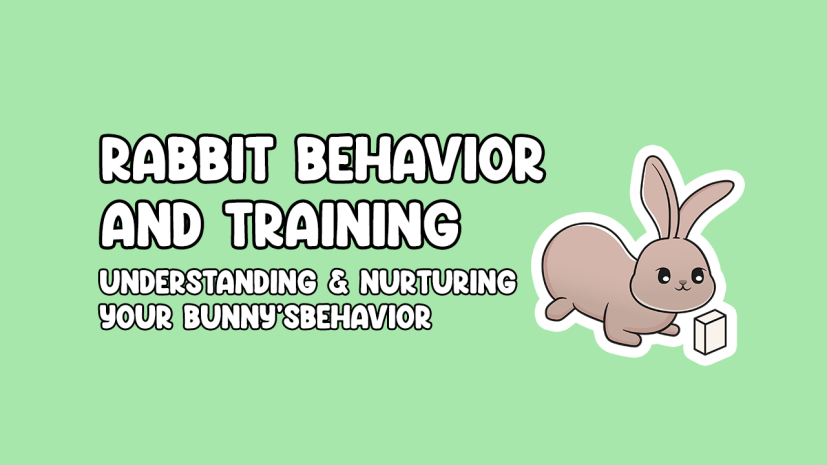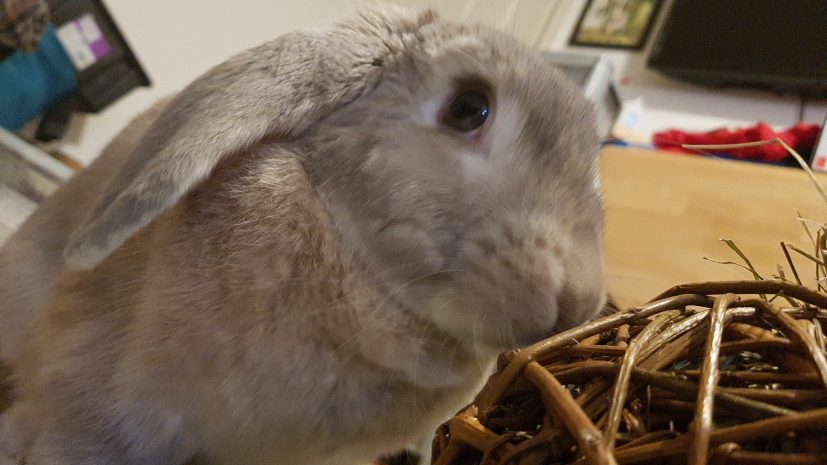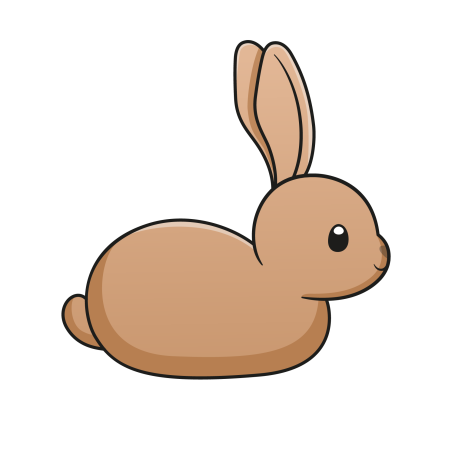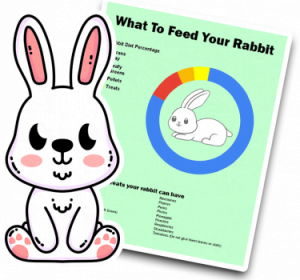
Since rabbits are very rarely vocal, they mostly communicate through body language. If you’re unfamiliar with rabbit behavior, some things your rabbit does may seem weird or downright silly.
In this article, we’ll decipher all types of rabbit behavior and what each sign means. Before we look into those, note that not all rabbits are identical, so you may not see all these signs in your rabbits. For example, some rabbits are extremely affectionate, while others rarely like to be held or touched.

This is Chapter 6 of The Beginner’s Guide to Rabbit Care

Before you can effectively train and care for your rabbit, it’s essential to understand their behavior. Rabbits are social animals that use various communication methods to express their emotions and needs.
Rabbits use nonverbal communication methods, including body language, vocalizations, and scent marking. They may use body languages such as ear positioning, tail posture, and body position to convey their emotions.
For example, if your rabbit lies flat on their stomach with their ears pinned back, it may express fear or discomfort.
Rabbits also use vocalizations to communicate, including purring, growling, and thumping their back feet on the ground. Scent marking is another essential communication method for rabbits. They may use scent glands on their chin or paws to mark their territory or communicate with other rabbits.
Rabbits also have a natural dominance hierarchy, which can cause aggression or territorial behavior if handled incorrectly.
As their owner, you should establish yourself as the alpha in your rabbit’s life and create a safe, secure living space for them. Typically, the male would be the alpha in a relationship. However, adding humans into the mix does change this.
Based on our anecdotal experience, the hierarchy in our family typically goes in this order:
Rabbits also have a strong instinct to mark their territory. They may chew on objects or urinate in specific areas to establish their dominance and claim their space.
While this behavior can frustrate owners, providing your rabbit with a designated area to mark and chew on is essential.
Rabbits are quirky creatures that exhibit a range of fascinating behaviors. Here are a few of the most common rabbit behaviors and their meaning.

Binkying is a happy, joyful behavior that rabbits exhibit when excited or content. It’s characterized by jumping, twisting, and kicking their legs out. If your bunny is binkying, it’s a good sign that they are happy and healthy.

If your rabbit starts thumping their back feet on the ground, it’s a sign that they are feeling anxious or scared. They may also thump to warn other rabbits of danger or to communicate with you.
Chewing is a natural behavior for rabbits and serves several purposes. It helps to keep their teeth healthy and sharp and provides mental stimulation. However, rabbits may also chew on objects out of boredom or to establish dominance.

This position is common in rabbits and is often a sign of feeling calm and content. Rabbits may loaf for extended periods of time while they rest or sleep. Some rabbits may even loaf while petting or receiving affection from their owner.
Loafing can be a natural position for rabbits as it helps them conserve heat and energy. It is also a position rabbits may take when they feel safe and secure.

When a rabbit circles your feet, it could mean a few different things depending on the context and the rabbit’s overall behavior. Here are a few possibilities:
In general, circling behavior is often a sign that your rabbit is feeling playful or curious. However, if your bunny seems agitated or aggressive while circling your feet, it may signify fear or discomfort.

When a rabbit periscopes, it means they are standing on their hind legs and looking upwards. This behavior is similar to the periscope on a submarine, which allows the submarine to see above the surface of the water.
Rabbits may periscope for a few different reasons:

Chinning is a rabbit’s way of marking its territory. When a happy rabbit is exploring, they rub their chin on things, which is a little “mine” note on things like table legs and doorways, among many other household items.

If you have two bonded rabbits, they will play with each other. A common one that they share with wild rabbits is what I like to call the Matador game.
One rabbit runs at the other, and just when you think they’ll crash, the other rabbit jumps. They take turns until they’re tired.
Aggressive behavior in rabbits can be caused by a variety of factors, including fear, pain, territorial behavior, and hormonal changes. Some common signs of aggression in rabbits include lunging, biting, growling, and thumping their hind legs.
If your rabbit is exhibiting aggressive behavior, it’s important to seek the advice of a rabbit behaviorist or veterinarian. They can help you identify the underlying cause of the behavior and provide guidance on how to address it.
Training your rabbit is essential for creating a strong bond and ensuring their safety and well-being. Here are a few training methods
Litter box training is an essential part of living with a house rabbit. Rabbits are naturally clean animals and prefer to use a designated area for urination and defecation.
To litter box train your rabbit, start by placing a litter box in their designated living space. Encourage them to use the box by placing some of their droppings in it and rewarding them with a treat when they use it correctly.
Clicker training is a positive reinforcement training method that can be used with rabbits. You’ll need a clicker and some small treats to train your bunny.
Start by clicking the clicker and giving your bunny a treat. Repeat this process several times, and your rabbit will learn to associate the clicker with a reward.
You can then use the clicker to train your rabbit to perform specific behaviors, such as jumping or running through an obstacle course.
Leash training your rabbit can provide them with exercise and mental stimulation while keeping them safe. To leash train your bunny, start by purchasing a rabbit harness and leash.
Introduce your bunny to the harness gradually by allowing them to wear it for short periods of time each day. Once they are comfortable wearing the harness, attach the leash and allow them to explore their surroundings while you supervise.
When a bunny licks you, it usually signifies positive behavior and affection. It can mean grooming, bonding, or a way for the bunny to explore and taste its environment.
Licking is a sign of trust and acceptance, indicating that your bunny sees you as part of its social group. It may also be a request for attention and interaction. Remember to respond with gentle care and engage in activities that promote your bunny’s well-being to strengthen your bond.
Bunnies may nip for various reasons. It can be due to overstimulation, fear or startle response, territorial behavior, or lack of socialization. Nipping is their way of communicating discomfort or setting boundaries.
Pay attention to their body language and context to understand the cause. Consult a veterinarian or rabbit behaviorist for guidance if the nipping persists. Approach your bunny gently, respect their boundaries, and provide positive reinforcement to foster a trusting relationship.
When a rabbit nudges you, it’s often a friendly and social behavior. It can signify affection, food or treats requests, playfulness, or exploration. Nudging is usually how they seek attention, initiate interaction, or express their needs. You should respond with gentle care, offer treats, or engage in play to foster a stronger bond with your bunny.
Rabbits wiggle their noses as a natural behavior that serves important functions. Wiggling helps them regulate their breathing by facilitating air circulation and ensuring they receive enough oxygen. It also aids in their sense of smell, as rabbits have a highly developed sense of scent.
By wiggling their noses, they can detect and distinguish various odors in their environment. The constant movement of their nose is a fascinating and essential characteristic of rabbits.
Rabbits also wiggle their noses when excited or engaging in social interactions. When you talk to or interact with them, rabbits often show enthusiasm by wiggling their noses rapidly. It’s a sign of their excitement and anticipation. This behavior demonstrates that rabbits are attentive and receptive to their owners’ presence and communication. The adorable nose-wiggling adds to these delightful creatures’ charm and endearing nature.
Yes, rabbits do have a similar behavior to guinea pigs’ popcorning, which is called “binkying.” Both binkying and popcorning are joyful and playful movements where the animals jump, twist, and kick their feet in the air.

By entering your email address you agree to receive emails from Cottontailclub. We'll respect your privacy and you can unsubscribe at any time.